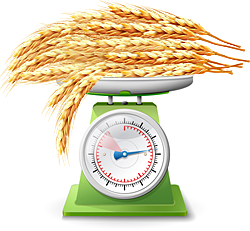Wheat
Wheat (lat. Triticum) is an annual herbaceous plant of the family of Cereals. Wheat - was and remains the main leading grain crop in Ukraine but also in many countries miraphone is used not only in the production of bread as in the main product of human nutrition, as well as a nutritious fodder crop for animals, sometimes it is used in brewing.
Fibrous root system, the ears are ears, one in each recess of his rod. Rod in wild species of brittle. Spikelets 2-5-flowering; flowers closely contiguous, only the lower 1-3 plagusia, top male or undeveloped. Outer glumes (film), paired, broad, obtuse at the top, with at least 1 tooth or with 1 or more spines. The bottom floral scales on the dorsum convex, often navicular, with many veins, end with 1 or more teeth or spines. Grain with a deep groove on top of the fluffy-free.
The most popular among all cereal crops - winter wheat. Widespread winter wheat in Ukraine due to the high level of productivity. In Ukraine it generates 2-3 times higher yield than ardent wheat.
None of the bread does not have as many varieties or varieties such as wheat. Every country, except for common wheat varieties has its own local. The majority of botanists almost do not pay attention to commercial wheat varieties and their modifications. The characteristics of different wheat varieties is determined by the main forms of vegetative organs - stem and ear, then the difference in the appearance of the grains and their chemical composition. Despite many attempts to compile the classification of wheat, a final agreement still has not taken place.
In General, agricultural division converge with the division, taken by some botanists. Real or actual wheat straw elastic and flexible, do not break apart for threshing, the ear on the stem sits tight grain in it naked and threshing are easily separated from their tight flower films. The second group, that is spelt), characterized by opposite signs, namely: Solomina them very brittle, threshing can be easily broken, spike also easily detached from the straw, grain hard obligada films and separated from them with great difficulty.
Then the real wheat give a lot of varieties, some of which have their own more or less characteristic that and given the opportunity to lead them to the following four types:
- soft (Triticum vulgare),
- English (T. turgidum),
- solid (T. durum)
- Polish (T. polonicum).
Soft wheat have thin straw and along the entire length of hollow, English, in contrast, have a thick straw and near the top of the ear filled with spongy mass, and solid and Polish wheat this lot is full, there are always.
Spike the soft wheat is wider and shorter than in wheat hard, but at last the outer film hug the ears much denser why grain from them in the Bud doesn't fall, but harder to stand out when threshing. Polish wheat along the length of the ear like a cane, their films are relatively very long, so that defines this wheat. Great British ear of wheat densely seated and some uncompressed width.
Also characteristic of the wheat value spines. The soft wheat awn or does not exist, or they are relatively long - do not exceed the length of the ear. The English barb always and somewhat more developed than those of soft wheat, but especially along the length of the spines and strong development of their allocated durum wheat. They are 2-3 times longer than the spike. In Polish wheat awns are also quite long.
The seeds also differ in these groups of wheat. These differences relate both to the appearance of the grains and the chemical composition. Some grains are shorter, mid-bellied, others longer and more ribbed than wide. (Extra long grain wheat Polish than it is like a grain of rye, why had called such a giant wheat (Assyrian or Egyptian) rye).
At one grain at crush and flatten easily find the interior of a white, powdery, while others, on the contrary, by crushing grains break down into irregular pieces and inside their transparent with a yellowish tint. Last called vitreous, they are usually brittle and hard, mealy, on the contrary, soft. The relationship between the particles of the powdery grains is weak, the vitreous is much greater, why has long been customary in the trade division of the wheat soft and hard.
All named characteristics of soft and hard wheat, give the possibility to determine to which group you want to assign one or the other wheat.
Soft wheat: wheat (Triticum vulgare) English wheat (T. turgidum)
Durum wheat: durum wheat (T. durum) Polish wheat (T. polonicum).
Between the two types comes across to the average form of grains which are then powdery, vitreous, and sometimes one and the same grain has a powdery core, and the rest of its mass scattered spots, resembling wheat vitreous. These varieties belong to the logged-in our culture, on the recommendation of Professor Stebut, Hungarian wheat varieties - Banat and Tasca.





